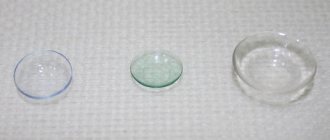Laser vision correction and the army - deferment of conscription after correction
Vision pathologies associated with refractive error are widespread among patients of any age.
Everyone knows that visual impairment can cause a deferment of service, so many conscripts are interested in asking how compatible laser vision correction is with the army.
The decision on whether a conscript is fit for military service is made only by a commission, so it is impossible to give a 100% answer to the question of whether the young man will be accepted for service or not after laser correction.
When and how is laser correction performed?
For farsightedness, myopia and astigmatism, laser correction is performed for patients over the age of 18 years. Modern methods of performing surgery can significantly shorten the postoperative period, after which patients return to a full life without restrictions.
The correction is carried out on an outpatient basis using one of the most suitable methods. The method of performing the operation is selected individually for the patient based on the examination results in order to ensure the most accurate correction without the risk of complications. The operation can be performed using a method with or without the formation of an upper corneal flap.
The most common methods are Lasik and Femto Lasik. The postoperative period after correction is about a month.
During this period, you need to limit physical activity, avoid falls, follow the ophthalmologist's instructions, and eliminate the risk of eye infection.
Prohibitions and restrictions on physical activity and contact sports are lifted after at least three months, when the corneal flap has fully grown in and the risks of its displacement are eliminated.
During the operation, the ophthalmologist first creates a flap from the upper corneal layer, which is pulled back to allow the excimer laser to access the inner layers of the cornea.
Under the influence of the laser, the cornea is vaporized and its curvature is corrected in accordance with the specified parameters, ensuring accurate refraction of the eye. After the correction is completed, the flap is returned to its place.
The patient’s task in the postoperative period is to maintain the achieved result, avoiding displacement of the flap and the development of inflammation. Following the doctor’s simple recommendations eliminates the development of complications.
Postponement of conscription after correction
Immediately after vision correction is performed, the army is included in the list of activity restrictions in the postoperative period, so the conscript is given a deferment of six months.
This time is enough for the complete restoration of the visual system and healing of the cornea.
After the deferment period has expired, the young man again undergoes a commission, which provides a conclusion on his suitability for service.
If during the postoperative period the conscript complied with all the rules and regulations of the ophthalmologist, the tissue healing process proceeds without complications. When the cornea is completely engrafted, there are no restrictions on physical activity and loads required by military service.
Vision correction for professional military personnel
For military personnel, high-quality vision is very important, since the performance of many official tasks requires one hundred percent vision.
The use of glasses or lenses significantly limits the military's capabilities, so such correction methods are unacceptable.
Laser vision correction in the army is the only solution to eliminate farsightedness, myopia or astigmatism in a military personnel, which impairs his professional suitability.
Depending on the type of military service and the specifics of the serviceman’s activity, a correction method is selected that will most accurately help correct vision without the risk of complications. For military personnel performing particularly dangerous tasks with an increased risk of injury, the Smile correction method is recommended.
During correction using the Smile method, the flap of the upper layer of the cornea is not cut off. The operation is performed using a femtosecond laser. To correct the curvature of the cornea in its middle layers, a lens of the required thickness is formed with a laser through a micro-incision and removed.
Thus, the postoperative period and healing takes place in the shortest possible time. Immediately after the operation, you can touch your eyes and not be afraid of the flap shifting, since there is none.
For the military, this advantage is important, since the recovery period and restrictions on professional activity are minimized.
If for some reason laser correction cannot be performed, the clinic can select alternative correction methods.
An individual approach is applied to each patient, since the human body and visual system of each have their own characteristics, as well as existing vision pathologies. It is not uncommon for a patient to have several vision pathologies, which complicate treatment.
Even in the most severe cases, ophthalmologists will find the optimal solution to restore the patient’s vision to the highest possible level.
Source: https://mgkl.ru/patient/stati/lazernaya-korrekcziya-zreniya-i-armiya
Will they be drafted into the army after vision correction?
Young men often wonder whether it is possible to move into the category of eligible conscripts after corrective work to restore vision?
As you know, with the help of medications it is possible not only to cure a number of ophthalmological diseases, but also to restore visual acuity.
The decision is made directly by the military registration and enlistment office, and it will depend on the effectiveness of the treatment provided.
If the young man was indeed diagnosed with high myopia, then surgical intervention is necessary.
After the operation, conscription into the army is impossible. After surgery to restore or correct vision, the eyeball remains unchanged, which means that signs of myopia remain on the retina and will not disappear.
If a young man had previously passed a commission and was placed in one of the groups unfit for service, and at the last examination by a doctor, the diagnostic results were different, then such a young man may be drafted into the army.
Temporary exemption can be obtained by those men who have undergone laser vision correction. In this case, a deferment is given for a certain time, depending on the state of rehabilitation the conscript is in.
Those persons who have received a military ID and upon completion of receiving the ID have undergone vision correction are not conscripted into the army.
Vision and the army | What kind of vision is not accepted into the army?
People with poor eyesight are not accepted into the army.
But what meaning does the military commissariat give to the word “bad”? Usually, the opinions of military registration and enlistment office doctors and young people differ on this issue. To understand in what cases people with poor vision are recruited into the army, you need to refer to the Schedule of Diseases - a document on which members of the medical commission rely when determining fitness for service.
The army and vision are a broad topic.
There are dozens of eye diseases, and for each of them a separate category of suitability is set:
- “A” – fit for military service;
- “B” – fit for service with minor restrictions;
- “B” – limited suitability for service;
- “G” – temporarily unfit, deferred from the army due to vision;
- “D” – not fit for military service.
Let’s take a closer look, using the example of different diagnoses, to determine whether people with poor eyesight are recruited into the army.
Myopia and liberation from the army
Myopia or myopia is an eye disease in which the curvature of the lens is impaired and a person cannot focus on objects that are far away.
Examination for myopia is carried out according to Article 34 of the Schedule of Diseases. It is believed that vision up to -6 diopters in the army does not interfere with service. You can get a military ID card based on your vision only if your myopia is more than 6 diopters. The suitability category in this case corresponds to the following indications:
- “B” – more than 6 and up to 12 diopters;
- “D” – more than 12 diopters.
Farsightedness and liberation from the army
Farsightedness also occurs when the lens is bent. If at least one eye has such a disorder, a diagnosis of hypermetropia is made.
If a conscript has confirmed hyperopia of any eye in one of the meridians of more than 8.0 diopters, then the military registration and enlistment office will have to exempt him from conscription. The indicators of farsightedness for exemption from the army should be as follows:
- “B” – more than 8 and less than 12 diopters;
- “D” – more than 12 diopters.
In other cases, the young man is recognized as fit for service in certain branches of the military.
Astigmatism and the army 2020
There are three forms of astigmatism: mixed, simple or complex astigmatism. You can end up in the army with any of them, since when determining fitness, doctors look not at the type of pathology, but at the degree of its development:
- Weak - the difference in refractions in two meridians is up to 3 diopters,
- Average - the difference in refractions in two meridians is 3-6 diopters,
- Strong - the difference in refraction in two meridians is more than 6 diopters.
Whether someone with eye astigmatism is accepted into the army depends on the degree of visual impairment. Strong astigmatism corresponds to fitness category “D”.
With an average degree, the ophthalmologist of the military medical commission can put the category “B” or “C”. The non-conscription category “B” is set if the difference in refractions exceeds 4 diopters.
Those with astigmatism are recruited into the army if they have a weak degree and a moderate degree of up to 4 diopters.
Conscripts who want to get a military ID either do not know whether it is possible not to serve with their eyesight, or do not understand how to exempt themselves from conscription due to their illness. Read the real stories of conscripts who received a military ID in the “Practice” section.
Visual acuity and fitness for duty
During any medical examination, visual acuity is checked, which, according to the Schedule of Diseases, under certain indicators, can also be a reason for exemption from conscription.
Table 1. Visual acuity and fitness categories
| Suitability category | Units |
| D |
|
| IN |
|
Advice from the Recruit Help Service:
It is not always possible to fully determine the deviations characteristic of a particular disease when passing a medical commission. Therefore, I advise you to come to doctors with existing conclusions.
Do they take you into the army after vision correction?
With the help of drug intervention, you can not only partially or completely restore visual acuity, but also get rid of astigmatism. How will the treatment affect the possibility of conscription, what category of fitness awaits the conscript and whether a deferment from the army is granted after vision correction - the answer to these questions depends on a number of reasons. I'll tell you more about this.
The final decision of the military registration and enlistment office depends on the results of treatment. On the forums you can find information that the call is impossible. This is wrong.
When examining, the military commissariat relies on the results of the latest medical research.
Even if at the initial placement the young man was given category “B”, then by the time he is called up, the fitness category will be assigned based on the results of a new examination.
Let's sum it up: with what kind of vision will they not be accepted into the army in 2021?
Those with myopia of more than 6 diopters, farsightedness of more than 8 diopters, astigmatism of more than 4 diopters, and those with insignificant anatomical features of the eyelids and conjunctiva are not accepted into the army.
If a conscript has undergone vision correction and undergoes a recovery period, he is given a deferment from conscription. After its completion, you will need to undergo a new medical examination and a vision test. If the operation helped and the indicators correspond to the draft, then the conscript will be sent to serve.
With respect to you, Anna Nikolaeva, lawyer of the Assistance Service for Conscripts.
We help conscripts obtain a military ID legally.
Source: https://armyhelp.ru/osvobozhdenie-po-zdorovyu/osvobozhdenie-ot-armii-po-zreniyu/
Poor vision and the army
All men are assigned to specially designated groups, according to their state of health and the presence of diseases.
If a man has acute ophthalmological diseases and is also in the postoperative period, then even in this case the conscript can only receive a deferment from the army for a while.
As soon as the young man’s health is restored, he will immediately have to be drafted into the army for service.
Deterioration is inevitable: doctors talk about the new illness schedule for conscripts
According to an orthopedic traumatologist, most guys today go into the army completely unprepared: with high physical activity, deterioration of scoliosis is almost inevitable.
The Ministry of Defense and the Ministry of Health have revised the “disease schedule”: the list of diseases itself has not changed, but the approaches to their assessment and diagnostic criteria have been clarified. Now some conscripts who would have been unfit last year will be allowed to serve in the army.
Sputnik discussed the three most “massive” reasons for deferment (which conscripts will no longer be able to resort to) with specialized doctors. How do they evaluate innovations?
About scoliosis: no one thinks about the guys’ prospects!
One of the most controversial changes, which has caused a lot of noise online, will affect those who previously could avoid military service due to spinal curvature. The new edition paid attention to “second degree scoliosis with a curvature angle of 11–17 degrees.”
Now guys will be recruited into the army even with this disease: representatives of the Ministry of Defense Fr.
Sputnik asked an orthopedic traumatologist at a private metropolitan medical facility for comment, the doctor told a Sputnik correspondent.
According to an orthopedic doctor, a schoolchild with a curvature of even up to 10 degrees (we are talking about the first degree of scoliosis) is shown a so-called special medical group: this means that he goes to physical education with his classmates, but does not pass the standards for running and jumping.
“And if the curvature exceeds ten degrees, we generally talk about exercise therapy (physical therapy), these guys should do it in the clinic. Obviously, the mentioned 17 degrees does not stand up to criticism.
Representatives of the Ministry of Defense assure that the list of diseases has not been tightened, discrepancies have simply been excluded from it
In addition to pain, this is fraught with the development of early osteochondrosis of the spine. And if the muscle frame is weak, then under heavy loads the curvature can increase even though the growth zones are closed,” explained the orthopedic traumatologist.
According to the specialist, most guys today go into the army completely unprepared physically, and in this case, deterioration in health is almost inevitable. Such people should prepare for service (as far as possible).
“Preparation is needed, no matter how you look at it. It’s worth going to the gym to strengthen the muscular frame as much as possible, but without axial load on the spine: jumping and running are prohibited, as well as impulse load along the axis of the spine,” the doctor advised.
Sick leave after laser correction – a week
Another change will affect those who have undergone laser vision correction, now they are much less likely to have a delay.
“When called up for compulsory military service, citizens who have undergone optical reconstructive operations (...) are recognized temporarily
unfit for military service if less than 3 months have passed since the operation,” the updated instructions say; previously the deferment was six months and allowed the conscription to “fly by.”
The fitness category after surgery is determined depending on the state of the eye functions: a conscript can join the army no earlier than 3 months after the operation “in the absence of postoperative complications and degenerative-dystrophic changes in the cornea and fundus.”
As the Ministry of Defense notes, “laser vision correction 10 years ago (when the previous resolution was adopted) and today are very different concepts.” According to Pavel Belyakovsky, an ophthalmologist, candidate of medical sciences, head physician of the Voka Eye Microsurgery Center, this is truly a low-traumatic, minimally invasive surgery: science does not stand still, so the delay period has been reduced.
“We do not penetrate inside the eyeball (the operation is performed on the cornea), moreover, modern laser equipment is now used. As a result, rehabilitation is quite fast, with the exception of individual, complicated cases. With standard surgery, sick leave is issued for seven days,” the doctor explained.
A conscript can join the army within three months after the operation
According to Belyakovsky, patients are limited in computer use for the first few days. As for physical activity, there are no contraindications: Olympians are allowed to train as usual after a month.
“We do not recommend visiting the gym, swimming pool, sauna and bathhouse in order to exclude any inflammatory phenomena (for example, dust from an air conditioner, which can cause contact conjunctivitis; bleach),” he explained.
A week after laser correction, a standard examination is carried out. And within a month, according to the ophthalmologist, the cornea is completely restored, and then the patient visits the ophthalmologist only if there are complaints.
Retinal surgery is more serious!
Those who have problems with the retina should be wary of physical activity: in particular, vitreoretinal (laser-coagulated) dystrophies, says the ophthalmologist. At the same time, the updated “schedule of illnesses” states that conscripts in this category are considered unfit only if they underwent surgery within three months before conscription
“Conscripts who have undergone the above operation (laser photocoagulation for peripheral retinal degeneration - Sputnik) on one or two eyes more than three months before conscription, in the absence of other contraindications, including progression of the disease, are considered fit,” the instructions state.
However, according to many ophthalmologists, it is the retina that deserves close attention.
Modern vision correction surgeries are minimally invasive and minimally traumatic
“You should judge by the retina: there are vitreoretinal dystrophies that can lead to tears that a person may not feel, and then to detachment and even loss of vision. After laser coagulation, healing is monitored by inviting the patient for examinations in a month, three, and six months,” said Pavel Belyakovsky.
A mole is not a contraindication
Another change affected moles (nevi). It was previously thought that they might interfere with the wearing of military uniforms, but the Ministry of Defense says that in recent years the uniforms have become softer.
“Medical examination of military personnel (...
) in the presence of frequently injured nevi (with confirmation of the facts of traumatization by medical documents) with signs of inflammation and (or) ulceration when they are localized in areas of traumatization caused by wearing military uniforms, shoes or equipment, if they refuse to be removed, it is carried out according to point “b” of this article (NGM),” the document specifies.
In the Ministry of Defense Fr. Due to the correction of this point, doctors are not sounding the alarm.
“Nevi (moles) are benign formations. If the nevus is constantly injured and inflamed (or if it is a giant/multiple nevus), the recruit will still be ineligible. But in themselves they are not a contraindication for military service,” says dermatologist Svetlana Gromakovskaya.
The current uniforms issued in the army do not injure moles, experts are sure
According to her, during examination, each case must still be considered by a doctor individually, since trauma can lead to serious consequences.
“Permanent injury to the nevus can lead to the degeneration of the pigmented nevus into melanoma, a malignant tumor. It is important to understand: this will not necessarily lead to malignancy, but there is such a possibility,” she explains.
Nevertheless, the dermatologist considers the innovation expedient: it is reasonable to recognize a conscript as unfit immediately after a case of traumatization of a mole is recorded.
What the Ministry of Defense says
In the relevant department, the adjustments are called planned: the previous list of diseases lasted 10 years, while “medicine has stepped forward,” the ability to diagnose and treat various types of diseases has increased.
The Ministry of Defense also analyzed the health requirements for conscripts in other countries (including Russia). They also took into account the requirements for people who engage in heavy physical labor and found inconsistencies: “to the point that a young man is fit for professional sports, but not fit for service.”
As the head of the military medical department of the Ministry of Defense of the Republic of Belarus, Colonel of the medical service Dmitry Alkhovik, previously explained, the now excluded loopholes “were not due to the true state of health, but to the possibility of double interpretation.”
“The task is not to fulfill an artificial plan for conscription. No one is interested in a citizen who is unfit for military service for health reasons, suffering, his commanders and parents suffering with him.
And the military medical service was distracted not by carrying out its tasks, but by treating the soldier, not related to combat training,” said Andrei, a consultant at the position of senior officer of the 1st department of the 1st directorate of the main organizational and mobilization directorate of the General Staff of the Armed Forces of Belarus Murashov during a round table at the Sputnik press center.
Representatives of the Ministry of Defense emphasize that they are not going to “row everyone” after the changes: the health requirements correspond to the needs of the army. According to the department, over the past 10 years in Belarus the number of conscripts called up for military service has halved.
Source: https://onlinebrest.by/novosti/uhudshenie-neizbezhno-vrachi-o-novom-raspisanii-bolezney-dlya-prizyvnikov.html
What kind of vision is not accepted into the army in 2021? we repay our debt to our homeland: do they enlist in the army with squint?
Dear readers!
Our articles talk about typical ways to resolve legal issues, but each case is unique. If you want to find out how to solve your particular problem, please use the online consultant form on the right or call (extension 784). It's fast and free!
The medical examination before enlistment in the army is aimed at diagnosing all organ systems. Special attention is paid to an ophthalmological examination: not only on-site diagnostics are carried out, but also information entered into the medical record throughout the conscript’s life is studied.
Many conscripts try to feign eye diseases and visual impairments in order to get out of service. But, as a rule, attempts to deceive do not lead to the desired result, since modern diagnostic methods (especially instrumental ones) make it possible to reveal deception with 100% accuracy. If the deception is revealed, the conscript will face criminal liability.
Is it possible to do military service with a disease?
There are several types of strabismus:
- Friendly: squints one or both eyes in turn.
- Hidden: the eye deviates to the side only when covered with something and only then ceases to participate in the visual process.
- Imaginary: the appearance of strabismus due to the structural features of the skull or eye sockets.
In cases of imaginary and hidden strabismus they are accepted into the army, but in cases of friendly strabismus - not always. The ophthalmologist checks visual acuity and the angle of strabismus: if it is more than 15 degrees, a delay will most likely be prescribed.
Visual acuity is also important for the examination, since strabismus often accompanies myopia or farsightedness. If your eyesight is very poor, you may not be allowed into the army.
Usability table with strabismus
The table reflects the data according to which the medical commission makes a decision on the suitability of a conscript for military service.
| Category | Requirements |
| A | Imaginary or hidden strabismus; slight decrease in visual acuity; the presence of small defects that do not impede life activity. Good. |
| B | Normal vision; small defects of the visual analyzer with concomitant strabismus. Good with restrictions. |
| IN | Pathologies as in the previous paragraph, but to a more severe degree. Good with restrictions. |
| G | Monocular strabismus. Temporarily unusable. |
| D | Strabismus up to 15 degrees; severe strabismus with an absolute lack of binocular vision. Unfit. |
We pass the medical examination
During the medical examination, the ophthalmologist performs a number of diagnostic methods. Evaluated:
- degree of strabismus;
- diplopia;
- visual acuity;
- whether or not there is paralysis of the eye muscles;
- damage to motor muscles.
If a conscript is found to have concomitant strabismus and associated impairment of binocular vision, he is sent to military service with restrictions. In some cases, basic diagnostic methods are not enough and additional ones are carried out:
- color test;
- Kalfa test;
- identification of the angle of strabismus;
- study of visual field disorders and others.
Based on the data obtained, a verdict is made.
How to get category D with strabismus
Whether the candidate will be accepted into the army or given a deferment depends on the opinion of the ophthalmologist. The doctor evaluates the form, provoking factors, degree of progression and the possibility of curing the pathology. To assess the possibility of avoiding military service if you have strabismus, you must undergo an examination by an ophthalmologist in a private or public clinic before a medical examination.
The presence of strabismus does not always indicate the impossibility of accepting a candidate for military service. The conclusion is issued in accordance with the ophthalmologist’s instructions and an assessment of the degree of pathology.
What fitness category is it allowed to take with strabismus?
The surge in ophthalmological diseases provoked not only the widespread opening of laser vision correction clinics, but also amendments to laws and articles on conscription for military service. So, what category of fitness will your diagnosis put you in:
Source: https://911urist.com/armiya/berut-li-v-armiyu-s-kosoglaziem-vozmozhna-li-sluzhba-v-vooruzhennyx-silax-i-strabizm-odnogo-ili-dvux-glaz.html
Myopia and the army
Myopia is a very common diagnosis, as is farsightedness. Rather, today this is not even considered a disease, since almost every second person has problems with visual acuity and is included in one of the groups: farsighted or nearsighted.
Myopia is characterized by a violation of the shape of the lens, namely curvature, which subsequently leads to the inability of a person to focus his gaze on any objects.
Conscription into the army is possible with a diopter from -1 to -5. You can get a military ID with this diagnosis if more than 6 units of diopter are recorded.
If during your military service your vision begins to change dramatically, then your service must be terminated.
Laser vision correction and the army List of diseases | Schedule of illnesses
Article number: 36 — Fitness category: G
For a conscript who has undergone laser vision correction, the question becomes whether he will be drafted into the army after this procedure. To answer this question, let’s turn to the Schedule of Diseases and understand the situation.
Vision correction surgery is not performed if there are any concomitant eye diseases (for example, cataracts, retinal dystrophy or retinal detachment), as well as if the conscript has complex diseases such as diabetes, immunodeficiency conditions, autoimmune diseases. If the doctor is convinced that the operation is possible, then after vision correction it is necessary to follow the rules and recommendations for two weeks. If there are no complications and you feel well, then a month after vision correction you can completely return to normal life.
Thus, complete recovery is possible a month after laser vision correction surgery.
For this reason, after the procedure and for another six months after its completion, conscripts are provided with a deferment, that is, they are assigned fitness category “G” under Article 36 of the Schedule of Diseases.
After graduation, the conscript undergoes an examination on the current state of visual functions.
However, in some cases complications may occur. Let's look at them. These include: insufficient or excessive correction, since it is impossible to guarantee perfect accuracy with an accuracy of one.
However, after vision correction, a conscript has every chance of full restoration of visual functions. In this case, the examination is based on visual acuity.
If the deviations are insignificant, the conscript will receive a draft fitness category.
If the conscript does not comply with the requirements and recommendations given by the doctor, then the flap may be lost or its position may change. In this case, additional surgery is required, and the recovery period is significantly longer. Most likely, the conscript will receive a non-conscription category if the degree of decline in visual functions remains reduced.
Cloudiness of the cornea can also become a complication after laser vision correction in a conscript. Eliminated by an additional procedure. The conscript must receive additional time for the recovery period after surgery.
In extremely rare cases, 3-5% of all cases, inflammation may occur due to infection entering the surgical site. It is necessary to use eye drops; in some cases, treatment lasts up to one year; for the entire period, the conscript must receive a temporary fitness category “G”.
Loss or damage to the flap within a month after surgical vision restoration is even less common. In this case, loss of vision is observed as a result of clouding of the cornea, which also leads to a decrease in visual acuity, and urgent measures for restoration are required.
Some complications appear only in the first days, usually disappearing within the first month. If they do not go away, treatment is required, or treatment does not help, then the conscript must be left at home to maintain therapy.
Based on the results, both conscription and release from the army are possible, depending on the degree of visual functions. Therefore, of course, you should not count on complete exemption from the army just because of laser vision correction.
It is important to pay attention to the “quality” of your vision and eye condition.
Article number: 29 — Suitability category: B
Conscripts who come for a medical examination at the military registration and enlistment office are often diagnosed with diseases of the organs of vision.
Some of them have already been diagnosed with corresponding entries in the outpatient card, but in some cases they have not been officially confirmed.
Eye diseases that qualify for exemption from service include blepharitis, but a number of conditions must be taken into account.
Features of the disease
Blepharitis is considered to be inflammatory changes involving the edge of the eyelid. The clinical form can be a pathology with a simple, ulcerative, scaly or meibomian manifestation. It is caused by infectious and non-infectious factors.
In the first case, the disease is provoked by bacterial, fungal, viral agents and the action of arthropods. The second type of reason is due to the action of allergens. Symptoms vary in severity.
The eyelid begins to turn red, its edges increase in volume, and begin to swell with loss of eyelashes. Itching appears, the degree of sensitivity to external factors increases, and the formation of scales and ulcers is possible.
In the absence of proper treatment, vision deteriorates, damage to the cornea of the eye is observed, and scarring is likely to form.
What fitness category can you count on?
The most common form of blepharitis is simple. In this case, individual scales may form with a slight manifestation of hyperemia at the edges of the eyelids. There is no anatomical disturbance, the functionality of the visual organs as a whole does not deteriorate. Therefore, the conscript will be declared fit, he will be assigned the B-3 fitness category and he will be drafted into the army.
Possibility of release from service
You can count on receiving category “B” with a definition of limited suitability for service in the presence of pronounced ulcerative blepharitis, when cicatricial degeneration and baldness along the edges of the eyelids are observed.
This process can affect either one eye or two at the same time. Ulcerative blepharitis is characterized by the formation of yellow crusts, as well as ulcerative phenomena on the surface of the eyelids.
This means that the inflammatory process has spread to the hair follicles of the original type.
Astigmatism
Astigmatism is an ophthalmological disease that results in the curvature of the cornea or lens of the eye.
Due to these changes, the image appears uneven and blurry. That is, it is difficult to catch a clear picture of an object located at completely different distances.
In medicine, it is customary to distinguish three types of this disease:
- Weak form; 3 dioptres;
- Medium shape; from 3 to 6 diopters;
- Strong form; more than 6 diopters.
This disease, like astigmatism, is not always treated. Doctors first assess the degree of visual impairment and only on the basis of such indicators can they draw an accurate conclusion and make a decision.
If a young man has severe astigmatism, he is exempt from military service. You can serve in the army if you have such a disease, if the degree of the disease is weak or moderate and reaches no more than 4 units of diopters.
In other cases, guys are assigned to other categories that allow them to take a deferment from military service, as well as serve in certain troops for health reasons.











